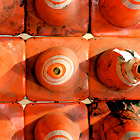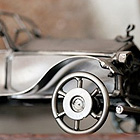
Auto-x Tips

- As soon as you pass the start line, you are only losing time. Minimize how much time you lose. It's not just going faster, it's spending less time on the course.
- The trick is to drive 10/10ths. A novice will drive 7/10ths and then not realize that they went to 13/10ths. Learn the edge and drive it. That may mean some cones get hit and you spin. It's what teaches you where 10/10ths is.
- There are fast parts and there are slow parts. Learn the difference.
- Don't square off the corners and point and shoot drive. A lot of corners are parts of smooth arcs you can make. It's faster to drive a smooth arc than a short straight and two jerky turns.
- Be aggressive in chicanes. Attack them, stay in front of the turns and as straight as you can. Getting "behind" in a chicane is a bad thing.
- Doing this well means being smooth. Being smooth DOES NOT mean you are slow. To drive the car smoothly may require controlled chaos in the car. Fast hand and foot movements do not mean you are not smooth.
- Know your line you intend on driving. Understand it. Look for it. If you drive such that you are forcing yourself off that line, you made a mistake and need to slow down. The line is everything, unless you are wrong about where the line is...then you need to change your mind.
- Look ahead to where you want to exit the turn. Adjust your speed into the corner to make sure your car will be on the right spot when your exit the corner.
- It's better to corner under acceleration than braking. Brake earlier and then get on the throttle as quick as you can.
- The earlier throttle points will be faster. Give up the end of the straight to make your corner exit faster. That speed coming out of the corner will carry thru the whole straight following the corner.
- Do not try to save runs. If you get screwed up, go off course or mow down cones. This saves tires.
- Understeer is often caused by going in to a corner too hot. To reduce understeer, straighten out the steering and/or reduce throttle input.
- A lift or quick stab at the brakes can cause the front of the car to weight and allow better turn in.
- Alignments are important.
- If you start going slower or are less succesful than you should be, check the car. Sometimes things change and it's hard to notice.
- Seat time is important.
- Autocross deliberately. Try to drive deliberately. Not just reacting...but control the steering and drive the line. Then do it faster.
- Don't worry about long lists of tips. Work on one or two things at a time. Don't try to adjust everything, put in a new swaybar and struts, try out Hoosiers, and decide to use left foot braking all in one weekend. Make changes one at a time and see how they feel.
- There are many ways to setup your car and your driving can accomodate them. Spend more time on your driving than your car setup. Human nature is that it's easier to point to your car, or the classing, or maybe someone else is cheating, or they spent more. But the biggest variable in autocrossing is still always the driver.
http://chasecam.com/

Andy's Top Ten Auto-x Driving Tips
By Andy HollisAndy is a multiple National Solo Champion and an instructor for the Evolution Solo School
Originally posted on Miata.Net
[Just got back from a weekend of teaching Evolution schools and thought I'd share some stuff that I must have said a thousand times.]
- Position first, then speed. Positioning the car perfectly is more important than trying to attain the highest potential speed. For example, you will drop more time by correctly positioning the car nearer to slalom cones than you will by adding 1 or 2 MPH in speed. Same with sweepers (tight line). Same with 90-degree turns (use all of the track). Also, position is a prerequisite for speed. If you are not in the correct place, you will not be able go faster. Or at least not for very long!
- Turn earlier...and less. To go faster, the arc you are running must be bigger. A bigger arc requires less steering. To make a bigger arc that is centered in the same place, the arc must start sooner (turn earlier).
- Brake earlier...and less. Waiting until the last possible second approaching a turn and then dropping anchor at precisely the correct place so that the desired entry speed is reached exactly as you come to the turn-in point is quite difficult to execute consistently. Especially when you consider that you get no practice runs on the course, and the surface changes on every run, and you aren't likely to be in exactly the same position with the same approach speed on every run, etc. Better to start braking a little earlier to give some margin of error. And by braking less you can either add or subtract braking effort as you close in on the turn-in point. This will make you consistent and smooth.
- Lift early instead of braking later. Continuing with the philosophy of #3, when you need to reduce speed only a moderate amount, try an early lift of the throttle instead of a later push of the brake. This is less upsetting to the car, is easier to do and thus more consistent, and allows for more precise placement entering the maneuver (remember #1 above).
- Easier to add speed in a turn than to get rid of it. If you are under the limit, a slight push of the right foot will get you more speed with no additional side effects. On the other hand, if you are too fast and the tires have begun slipping, you can only reduce throttle and wait until the tires turn enough of that excess energy into smoke and heat. Don't use your tires as brakes!
- Use your right foot to modulate car position in constant radius turns, not the steering wheel. In a steady state turn, once you have established the correct steering input to maintain that arc, lifting the throttle slightly will let the car tuck in closer to the inside cones. Conversely, slightly increasing the throttle will push the car out a bit farther to avoid inside cones. It is much easier to make small corrections in position with slight variations in the tires' slip angle (that's what you are doing with the throttle) than with the steering wheel.
- Unwind the wheel, then add power. If the car is using all of the tire's tractive capacity to corner, there is none left for additional acceleration. At corner exit, as you unwind the wheel, you make some available. If you do not unwind the wheel, the tire will start to slide and the car will push out (see #6 above).
- Attack the back. For slaloms (also applicable to most offsets), getting close to the cones is critical for quick times (see #1). To get close, we must move the car less, which means bigger arcs. Bigger arcs come from less steering and require earlier turning (see #2). Now for the fun part... When you go by a slalom cone and start turning the steering wheel back the other way, when does the car start to actually change direction? Answer: When the wheel crosses the center point (Not when you first start turning back!) How long does that take? If you are smooth, it takes .25 - .5 seconds. Now, how long is a typical person's reaction time? Answer: about .5 seconds. Finally, how long does it take to go between slalom cones? Answer: Typically on the order of 1 second. Given all of that, your brain must make the decision to begin turning the steering wheel back the other way just *before* you go by the previous cone!!
Since this is a mental issue, a good visualization technique to get used to this is to think about trying to run over the back side of each slalom cone with the inside rear tire of the car. To hit it with the rear tire (and not the front), the car must be arcing well before the cone and the arc must be shallow. Attack the back! - Hands follow the eyes, car follows the hands. 'Nuf said.
- Scan ahead, don't stare. Keep the eyes moving. Looking ahead does not mean staring ahead. Your eyes must be constantly moving forward and back, and sometimes left and right. Glance forward, glance back. Your brain can only operate on the information you give it.
Permission to Publish below:
Andy Hollis Miata Forum Member Member # 3320 posted 18 March 2002 23:52
For those asking permission to reprint or copy elsewhere, no problem. I only ask that you keep my name attached for credit.

Anonymous
If you wrote this, please contact me.
- Walk the course with someone faster than you once, then walk it by yourself as many times as possible after that to let it sink in. I do one walk just thinking about braking zones, one for gearshifts, and one for line. Walking with your buddy is fun, but will distract you and you won't get as much out of walking the course.
- There are places where you must brake, obviously, but one rule I have found is that brakes only slow you down. Don't overbrake. Spend more time being smooth on turn in, and less time on the whoa pedal, and you might surprise yourself on how much more speed you can carry into any given turn. Keep it controlled, and smooth. A personal trial I am constantly facing.
- You are not so fast that you are done learning. Yes, even the class leaders. There is always someone faster. Learn from it.
- Until you can do the course in your head, you are not done walking. Know where the apexes are for each.
- Don't overdrive. (easier said than done, but you know when you are doing it)
- Stay hydrated, this will keep you calm and level. Water is best, even in overcast weather.
- Run on street tires as long as you can stand it. They will not hide your mistakes like R tires will.




